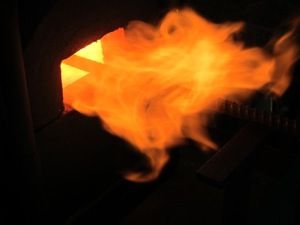 One of the challenges in forge welding is preventing the surfaces that you want to weld together from oxidising when heating. If they do oxidise, then the weld can have inclusions or gaps, which can open up later. A flux is used to stop this surface oxidation, or to dissolve it. For years I had used Borax to prevent this. When the pieces were heated, the Borax powder was sprinkled all over the surfaces, allowed to melt, then the pieces were hammered together. The problem with Borax is that it is highly corrosive when liquid, especially bad for the forge lining. Borax can easily eat through the lining in a session. To prevent this, I filled the bottom half of the forge with some sacrificial kitty litter (the clay type), which mostly caught the Borax. This didn't protect the sides though.
One of the challenges in forge welding is preventing the surfaces that you want to weld together from oxidising when heating. If they do oxidise, then the weld can have inclusions or gaps, which can open up later. A flux is used to stop this surface oxidation, or to dissolve it. For years I had used Borax to prevent this. When the pieces were heated, the Borax powder was sprinkled all over the surfaces, allowed to melt, then the pieces were hammered together. The problem with Borax is that it is highly corrosive when liquid, especially bad for the forge lining. Borax can easily eat through the lining in a session. To prevent this, I filled the bottom half of the forge with some sacrificial kitty litter (the clay type), which mostly caught the Borax. This didn't protect the sides though.
A new method of fluxing is to use Kerosene. By soaking the pieces in Kerosene before heating, you coat the surfaces in the oily liquid. When the steel is put into the forge, the Kerosene burns off, leaving a layer of carbon coating the surface, which inhibits oxidisation. The advantages is that Kerosene can get into cracks and doesn't harm the forge lining. This will not work with already oxidised surfaces, they need to be clean to start with. Borax would still needed to dissolve the scale. But using Kerosene to start with, greatly improved the success of your first welds and limits the need of Borax.
Safety note: make sure you have the Kerosene in a fireproof container, with a lid. Don't put red hot pieces of steel in the Kerosene. Although it doesnt explode, it can flare up. And the fumes aren't too good for you either,